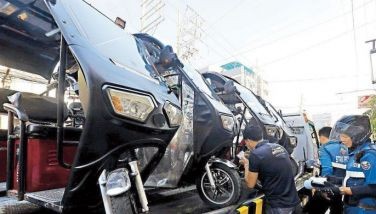Poll watchdog probing auto poll security issues

MANILA, Philippines — Was the automated election system (AES) used by the Commission on Elections (Comelec) in the midterm polls compromised?
Poll watchdog Parish Pastoral Council for Responsible Voting (PPCRV) is conducting an extensive examination of the AES, particularly an audit of the logs in the transparency server to ensure the integrity of the system used by the Comelec.
PPCRV national chair Myla Villanueva revealed yesterday that their team of IT experts is examining whether there were external interventions on the system – especially during the seven-hour glitch at the start of canvassing.
“We are looking into those security issues. We will determine if there were interventions on the system,” she told The STAR.
But the PPCRV head was quick to qualify that any findings they would make would have to be carefully reviewed due to the sensitivity of issues involving the AES provided by Smartmatic.
“As you know, these security issues have a legal aspect so we cannot just divulge our findings. But yes, we are looking into that,” she said.
Villanueva further stressed that the determination of whether the AES was compromised was not limited to the audit of logs in the transparency server and technical examination of the system used in the polls.
“That is just one aspect. For me, what is more significant is the manual verification of the election returns. Remember, we have the fourth pre-transmitted copy of the ERs (election returns) and we consider that sacred,” she pointed out.
As of yesterday, the PPCRV has received 41,948 ERs from a total of 87,540 clustered precincts or 48.91 percent.
Volunteers of the poll watchdog have been working day and night at their command center in Pope Pius XII Catholic Center in Manila to cross-check the electronically transmitted results received from the transparency server with the actual ERs.
Villanueva earlier bared that they have examined the logs from the transparency server and confirmed the pronouncement of Comelec that the seven-hour blackout last May 13 was caused by a bottleneck in the transmission of data.
She said their IT experts found an apparent glitch in the file transfer manager application used in the server, which suddenly stopped functioning.
The PPCRV head believed that the Comelec should explain to the public why such glitch happened.
“This could have been prevented. But we’re talking of technology and glitches happen,” she commented.
Data complete
Despite the bottleneck, Villanueva said the data that entered the transparency server were complete.
The seven-hour glitch happened from 6:15 p.m. of May 13 until 1:19 a.m. of May 14 or the time the PPCRV and its media partners stopped receiving data.
Based on initial examination of the PPCRV’s IT experts, Villanueva said “the arrival stamps listed in the transparency server logs matched the time stamps of the election results files provided by the transparency server.”
“And they indicated that results were being transmitted throughout the period from 6:15 p.m. on May 13 to 1:19 a.m. on May 14,” Villanueva explained.
She also said that based on the application they developed to scrape data from the Comelec Public Access website and compare them against those in the transparency server, “the data matched.”
Villanueva said the transparency server got choked or “nabulunan” as shown by the file transfer manager module.
But she said that the PPCRV is not in a position to make any conclusion about the root cause of the problem.
“I’m not saying there is no problem in transmission, what we are saying is that data was coming into the transparency server despite the fact that our tally boards did not receive the data from the transparency server. The data was actually coming into the transparency server, it was not just being passed to us and the media and the tally boards of the different political parties,” she added.
She urged the media organizations and the political parties to ask the Comelec to give a more detailed explanation and to also get copies of the logs so they could scrutinize the data themselves.
Voter turnout
Voter turnout in the midterm polls was initially pegged by the Comelec at close to 75 percent as projected.
At a press briefing, Comelec spokesman James Jimenez said based on their initially count, 74.89 percent of voters cast their votes.
“We cannot compare the midterm with the 2016 elections because it was presidential. It’s like apples and oranges. But based (on other) midterms, we are having good results,” he noted.
Jimenez added the 74.89 percent voter turnout translates to 46,343,423 voters.
“It looks like we are on track to exceed the previous (2013 midterm elections). We are having good numbers now,” he said.
Asked for possible reasons for this, Jimenez said it could be because the candidates now are “colorful.”
Jimenez added he observed there is also an “engaged electorate” this election.
Data showed there are 63,563,792 registered voters, including 1,822,173 from abroad. – With Sheila Crisostomo
- Latest
- Trending


























